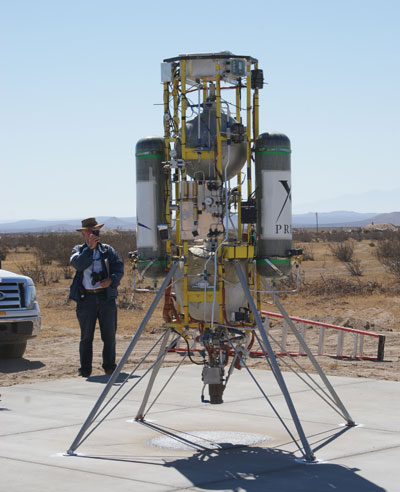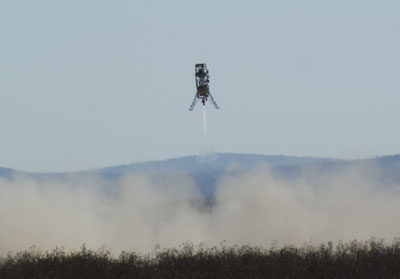A Xombie over Mojaveby Jeff Foust
|
| The only thing that caught people’s attention was when the vehicle appeared to tilt over excessively when it started its translation from above one pad to the other; it took many by surprise but it turned out to be exactly as planned. |
Or, rather, a “Xombie” flew, that being the nickname of Masten Space System’s XA-0.1B vehicle. On Wednesday Masten Space became the third team to fly a vehicle for the Northrop Grumman Lunar Lander Challenge (LLC), after perennial contender Armadillo Aerospace and last year’s TrueZer0. While Xombie completed only half of a full Level 1 flight profile, the flight demonstrated that the team is more than halfway towards staking a claim at the second-place prize purse—and perhaps make a run at Armadillo’s Level 2 money (see “Playing the waiting (and winning) game”, The Space Review, September 14, 2009).
Masten’s LLC attempt started bright and early at 5:30 am with a safety briefing at the airport’s offices, one that focused as much about the wildlife at the desert site—rattlesnakes, black widows, and more—as on the hazards posed by the vehicle. (“Leave it alone and it will leave you alone,” was the advice of Dave Masten, president and CEO of Masten Space Systems, regarding the wildlife.) Afterwards the small handful of observers—about a couple of dozen, including representatives of NASA and the FAA, later joined by airport manager Stu Witt and Scaled’s Burt Rutan—headed out to the observing site, 1,500 feet (450 meters) west of the flight site, and waited for Xombie to take flight.
Finally, at about 10 am, the pre-flight preparations were complete and, after a short countdown, Xombie lifted off. To observers, the vehicle appeared to be flying a normal Level 1 profile: up to an altitude of about 50 meters, across about 60 meters to the other pad, and then descending to a landing, remaining aloft 90 seconds as required under the Level 1 rules. The only thing that caught people’s attention was when the vehicle appeared to tilt over excessively when it started its translation from above one pad to the other; it took many by surprise but it turned out to be exactly as planned.
The first flight appeared to be a great success, particularly after the judges determined it landed less than 20 centimeters from the center of the pad. So it was a surprise, and a disappointment, when word came just a few minutes later that Masten was scrubbing their return flight, ending this bid for the Level 1 second prize.
 Xombie on the pad after its flight. (credit: J. Foust) |
The scrub, the Masten team explained, was caused because of a problem with the regeneratively-cooled engine chamber that created a localized heating spot. “Obviously it did the flight reasonably well, the engine didn’t go shooting off and knock the vehicle over,” Masten’s Ben Brockert said. But rather than risk the engine and the whole vehicle with a return flight, they decided to wait until some new engine chambers come in and can be tested.
Despite the failure to perform a complete Level 1 flight, the Masten team was visibly excited by Wednesday’s flight. It was only the second free flight of Xombie—with the first just the previous afternoon—and was far longer than the first. Their ability to fly one leg of the Level 1 flight profile with high accuracy raises their hopes that can fly a complete flight profile soon.
“I’m really happy about this flight, except for that little engine problem,” Dave Masten said. “It was what I was expecting or better.”
Masten has reserved two more windows for the LLC, one in October 7–8 and the other October 28–29. Masten hopes not only to fly Xombie in one of those windows for Level 1, but also a separate vehicle it’s developing for Level 2, the XA-0.1E (elided to “Xoie”, and pronounced like “Zoë”). Even while they’re gunning for Level 1 and 2 they’ll have competition from another team, Unreasonable Rocket, which is making progress on its vehicles and plans to compete at the end of October, just before the competition window closes.
| “I’m really happy about this flight, except for that little engine problem,” Dave Masten said. “It was what I was expecting or better.” |
There are also hints that another team registered for the competition before the September 15 deadline. Although there’s been no formal announcement from the X PRIZE Foundation, which runs the competition on behalf of NASA’s Centennial Challenges program, a tweet from the Centennial Challenge’s Twitter account indicated that another team was “in the running” for the competition “to be announced soon”.
Regardless if there’s another team or not, it looks like late October in particular will be an interesting time for the LLC. Given the location of the teams, that will make for a lot of activity in, near, and above Mojave—no Hollywood special effects required.
